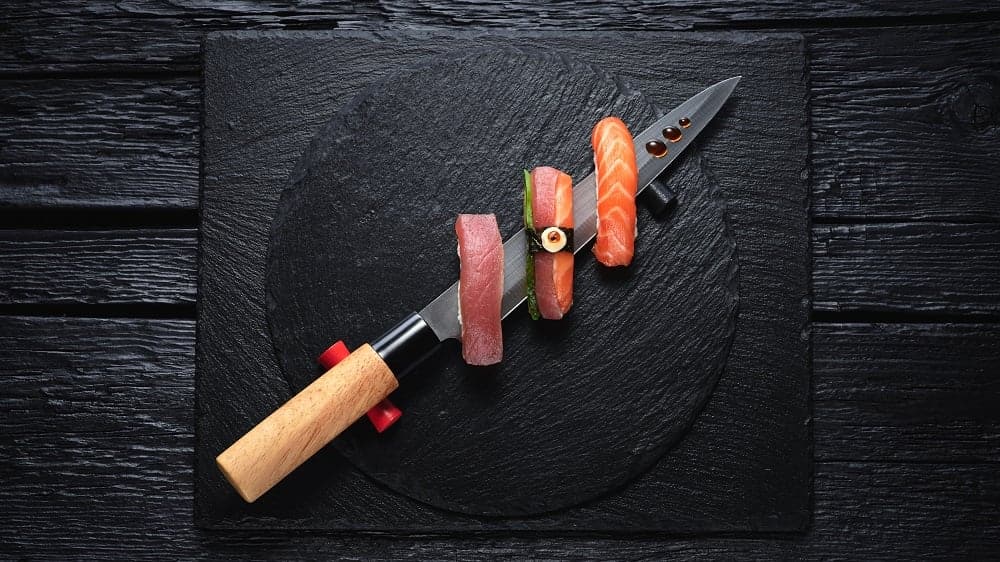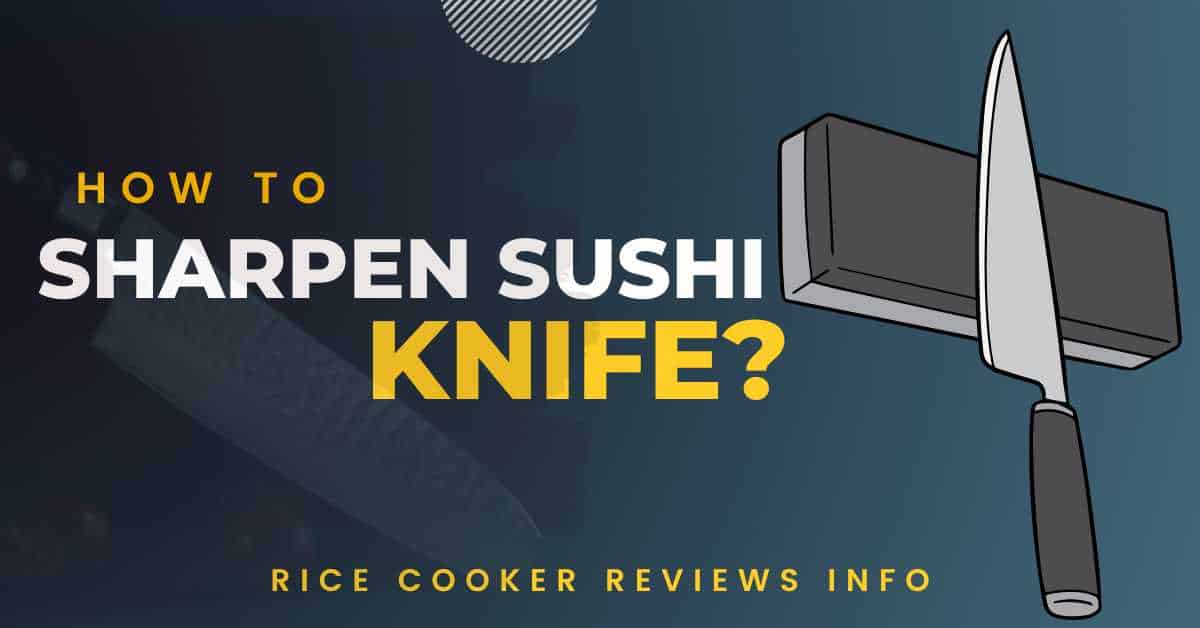Hey there! Are you a sushi lover? Do you have a sushi knife at home that doesn’t cut as smoothly as it used to? Don’t worry. You’re not alone! Many people struggle with keeping their sushi knives sharp and in top condition.
But here’s the thing – a dull sushi knife can make your sushi-making experience frustrating and unenjoyable. Not to mention, it can also compromise the quality of your sushi rolls. That’s why knowing How to sharpen a sushi knife properly is crucial.
In this guide, we’ll walk you through the steps of sharpening your sushi knife, from understanding the different types of sushi knives to choosing the right tool and technique. So, let’s get started!
The importance of sharpening a sushi knife

A sharp sushi knife is essential for any sushi chef, whether you’re a professional or love making sushi at home. Here are some reasons why sharpening your sushi knife is crucial
Efficiency:
A sharp knife will make cutting fish and vegetables easier and more efficient. You’ll be able to slice through your ingredients quickly and without resistance, resulting in a smoother and more precise cut.
Safety:
A dull knife can be dangerous as it requires more force to cut through ingredients, increasing the risk of slipping and injuring yourself. A sharp knife, on the other hand, will require less effort to make clean cuts, reducing the chance of accidents.
Quality of sushi:
A sharp sushi knife ensures that your ingredients are correctly cut, resulting in a better texture and presentation of your sushi rolls. A dull knife can crush the ingredients, affecting their texture and overall taste.
Longevity of knife:
Regular sharpening of your sushi knife can help prolong its lifespan. A dull knife can cause damage to the blade, requiring more frequent sharpening or even replacing the knife altogether.
Understanding Your Sushi Knife
Understanding your sushi knife is an essential step in sharpening it properly.
Types of sushi knives:
There are several types of sushi knives, each with unique features and uses. The most common ones include Yanagiba, Deba, and Usuba knives.
Parts of a sushi knife:
To properly sharpen your knife, you must understand its different parts. The main parts of a sushi knife are the blade, handle, tang, spine, and tip.
Blade material:
The blade of a sushi knife is made from different materials, such as carbon steel, stainless steel, or high-carbon stainless steel. Each material has advantages and disadvantages in sharpness, durability, and rust resistance.
Blade thickness:
The thickness of the blade can also vary depending on the type of knife. Yanagiba knives, for example, have a thin blades to make precise cuts, while Deba knives have thicker blades to handle tougher cuts of fish.
Blade length:
The length of the blade can also vary depending on the type of knife and the user’s preference. Yanagiba knives typically have a longer blade, while Usuba knives have a shorter one.
Choosing the Right Sharpening Tool
Choosing the right sharpening tool is crucial in properly sharpening your sushi knife. Here are some core factors to consider while selecting a sharpening tool:
Material:
Sharpening stones are the most popular tool for sharpening sushi knives. They come in different materials like ceramic, diamond, and natural stones like water. Each material has advantages and disadvantages, such as cost, durability, and effectiveness.
Grit:
Sharpening stones also come in different grit levels, which determine how abrasive they are. Lower grit stones are more abrasive and remove more metal from the blade, while higher git stones are less abrasive and create a smoother edge.
Honing vs sharpening:
Honing and sharpening are two processes requiring different tools. Honing is the process of realigning the blade’s edge to keep it sharp, while sharpening involves removing material from the blade to create a new edge. Honing requires a honing steel or ceramic honing rod, while sharpening requires a sharpening stone.
Type of Knife:
Different sushi knives may require different sharpening tools. For example, a Yanagiba knife may require a specific kind of sharpening stone with a finer grit, while a Deba knife may require a heavier grit sharpening stone.
Skill level:
Some sharpening tools, such as electric sharpeners, are easier to use than others. However, they might provide a different level of precision and control than a traditional sharpening stone.
Steps for Sharpening Your Sushi Knife
Here are the steps for sharpening your sushi knife:
- Preparing the sharpening stone: Soak it in water for the recommended time to ensure it’s wet enough for use. Place it on a non-slip surface to prevent any accidents.
- Positioning the knife: Hold the sushi knife firmly with one hand and place the blade at a 15 to 20-degree angle on the sharpening stone. Make sure to keep the angle consistent throughout the sharpening process.
- Maintaining the angle: Using your other hand, apply gentle pressure on the blade and slide it across the sharpening stone in a circular or back-and-forth motion.
- Starting the sharpening process: Begin with a lower grit stone and gradually work your way up to a higher grit stone, depending on the level of sharpness you want to achieve. Repeat the sharpening process on each side of the blade until you’ve achieved the desired level of sharpness.
- Checking for sharpness: Once you’re done sharpening, test the blade’s sharpness by slicing a piece of paper or a tomato. If the blade cuts through effortlessly, then it’s sharp enough. If you still need to, you may need to repeat the sharpening process.
- Clean and dry your sushi knife: Remember to clean and dry your sushi knife after sharpening to prevent rust or damage to the blade. Regular maintenance and proper sharpening techniques allow you to keep your sushi knife sharp and in excellent condition for years.
Here are some additional tips for sharpening your sushi knife:
Use honing steel: Honing steel or ceramic honing rod can be used to realign the blade’s edge between sharpenings. It’s a quick and easy way to keep the blade sharp and maintain its edge.
Take your time with the process:
Take your time when sharpening your sushi knife. Rushing the process can lead to uneven sharpening, and you may damage the blade.
Keep the blade clean:
Clean the blade of your sushi knife before and after sharpening. A dirty blade can affect the sharpening process and damage the sharpening stone.
Use a consistent angle:
Maintain a consistent angle throughout the sharpening process to ensure even sharpening on both sides of the blade. A constant angle also helps to maintain the blade’s original shape.
Avoid too much pressure: Applying too much pressure when sharpening your sushi knife can damage the blade and the sharpening stone. Use light to medium pressure and let the sharpening stone do the work.
Test the sharpness regularly:
Test the blade’s sharpness regularly during the sharpening process to ensure you achieve the desired level of sharpness. Don’t over-sharpen the blade, as this can make it brittle and prone to chipping.
Conclusion
Sharpening your sushi knife is essential for maintaining its sharpness and functionality. By understanding your sushi knife, choosing the right sharpening tool, and following the proper sharpening techniques, you can keep your sushi knife in excellent condition and achieve the perfect slice every time.
Remember to take your time, use consistent angles, and regularly test the blade’s sharpness for optimal results. With regular maintenance and proper sharpening techniques, your sushi knife can last many years and provide you with the best sushi-making experience possible.

